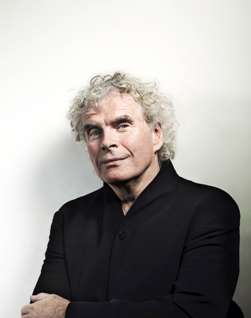|
Back
A Month of Mahler New York
David Geffen Hall, Lincoln Center
05/04/2018 - & April 18 (Dublin), 23 (Luxembourg), 27 (Zürich), 28 (Frankfurt), 29 (Hannover), May 1st (Birmingham), 5 (Newark), 2018
Gustav Mahler: Symphony No. 9
London Symphony Orchestra, Sir Simon Rattle (conductor)

S. Rattle (© Johann Sebastian Hanel)
“Kein’ Musik ist ja nicht auf Erden
Die uns’rer verglichen kann werden...”
(No music is there on earth
Which may be compared with ours…)
from Symphony No. 4 by Gustav Mahler
New York loves Mahler and this month is but a small example. The LSO is here for three concerts. On their night off, we Mahlerians can go down the street to Carnegie Hall where the Bavarian Radio Symphony with Mariss Jansons presents the 7t~h. Later in May the MET Orchestra will offer the 5th under the baton of Noseda and just over the line on June 5, Michael Tilson Thomas, a substitute for a former maestro (enough said), is scheduled to lead the MET ensemble in the 4th.
Although Henry-Louis de La Grange once told me that it was a myth that Mahler composed the beginning of the first movement of the 9th as a description of his irregular heartbeat, I maintain that, at least subconsciously, Mahler’s body was influencing him more than he was ready to acknowledge. Certainly his avid acolyte Arnold Schoenberg paid homage to his mentor when he composed his own String Trio with a noticeably hesitant opening following his own return from the hospital. In any case, it is a particularly ear-catching prelude whether emerging from a cerebral, psychological or biorhythmic embryo.
This was a decent performance, not one to write home about but one that delineated the proper perspectives throughout. Maestro Rattle began his career as a percussionist and he allowed his battery to shine. Crescendi in the first movement were allowed to develop slowly and dramatically, stretching the bounds of good taste but not breaking them. Ritards before these large effects were somewhat stretched to the limit, however we must allow for some dramatic exaggerations as Mr. Rattle’s personal statements.
Movement number two was notable for the spirit of its Ländlers, unrolled in this Leonard Bernstein town with just the right zaftig flavor even though this maestro is not Jewish. The Rondo-Burleske was somewhat slower than most – and consequently less exciting – but rallied to a more intense tempo towards its end, a conclusion that was simply spectacular and seemingly a bit out of place in this otherwise pedestrian performance.
The long slog finally began to take its toll on the individual musicians during the final Adagio as intonations suffered and attacks were blurred. There was definitely some embouchure trouble in a movement where every utterance is extremely important and nakedly emotional. Considering how short this performance was – there was no other work on the program – these slippages were both noticeable and a bit insulting. In the end we were all treated to the little Mahler that could – at least it thought that it could - but ultimately it did not reach the summit of its potential. Somewhat disappointing...
Taking his cue from the “Farewell” Symphony of Haydn, Mahler begins to consciously reduce the number of musical lines late in the fourth movement. After a shuddering string glissando the sound becomes thinner and thinner. As instruments drop out the music becomes only strands and the illusion is created that there is less than sufficient oxygen to the brain. The phrases seem to have lives of their own and the silences between them begin to increase. There is one frightening moment when all sound ceases but then there is a recovery which, however, is fleeting. The ending is pure memory, just isolated thought existing for its own sake. The “I” is gone forever. Pitts Sanborn, writing in the New York World-Telegram of a performance from November 19, 1931 wrote:
“...the music faded into the silence of eternity...
the last sleep which is our inalienable birthright.”
Mahler had done it. He successfully recreated in art what his last moments on earth would be and left this creation as his final testament.
Except that the fates had other plans. In spite of his best artistic efforts, Mahler didn’t die. He recovered sufficiently in 1910 to feel strong enough to continue to compose. He completed one movement of a proposed Symphony #10 (a searingly dissonant Adagio) and sketches for another four accompanying movements (it tantalizingly appears that Mahler would have opened the work with the internally wrenching slow movement). Several interesting reconstructions exist of the work as a whole, but they are sadly not pure Mahler (there is also a Concerto for Violin which exists in this bastardized form). Ironically the very machinations which Mahler employed to cheat the curse of the ninth symphony caused his last completed orchestral opus to be labeled as the Symphony #9. Sir Simon will be presenting both a reconstruction of the 10th and the lyrically powerful Das Lied von der Erde before leaving town. It should be a very eventful weekend.
Fred Kirshnit
|